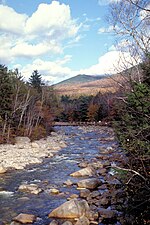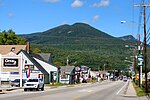Lost River Reservation
Caves of New HampshireLandforms of Grafton County, New HampshireLandmarks in New HampshireNature reserves in New HampshireProtected areas of Grafton County, New Hampshire ... and 1 more
Tourist attractions in Grafton County, New Hampshire

The Lost River Reservation (also known as the Lost River Gorge & Boulder Caves) is a protected area with a series of caves along a gorge in the White Mountains in Woodstock, New Hampshire, United States. Located 5 miles (8 km) west of the village of North Woodstock on New Hampshire Route 112, Lost River Reservation is set in Kinsman Notch. One of the White Mountains' major passes, Kinsman Notch lies between Mount Moosilauke and Kinsman Ridge at just under 2,000 feet (600 m) above sea level.
Excerpt from the Wikipedia article Lost River Reservation (License: CC BY-SA 3.0, Authors, Images).Lost River Reservation
Lost River Road,
Geographical coordinates (GPS) Address Website External links Nearby Places Show on map
Geographical coordinates (GPS)
| Latitude | Longitude |
|---|---|
| N 44.037777777778 ° | E -71.783888888889 ° |
Address
Lost River Gorge & Boulder Caves
Lost River Road
New Hampshire, United States
Open on Google Maps







